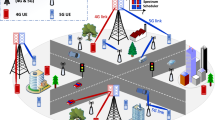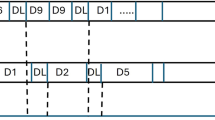Abstract
As the first standard for cognitive radio networks, IEEE 802.22 wireless regional area networks (WRANs) exploit television white spaces. Secondary networks have to preserve primary network communications and to coexist with other secondary networks. To support self-coexistence in the IEEE 802.22 WRANs, two spectrum access methods are provided; namely, spectrum etiquette and on-demand frame contention (ODFC). The IEEE 802.22 base stations conduct the spectrum etiquette if there is an exclusively available channel; otherwise, it performs ODFC. ODFC enables the base stations to share the operating channel. However, in ODFC, contention success or failure depends on a random number generator without other considerations and contention destination is randomly selected regardless of the traffic at the destination. This paper proposes a novel frame contention strategy called highly successful frame contention (HSFC). The outstanding features of HSFC are: (1) the contention source chooses the idlest base station as the contention destination (2) the contention source with more users has a higher probability to win the frame contention, and (3) the contention destination takes its own traffic condition into consideration when processing the contention request. The performance evaluation showed that the proposed HSFC increases contention success probability and throughput remarkably compared to the conventional ODFC.










Similar content being viewed by others
References
Christian, I., Moh, S., Chung, I., & Lee, J. (2012). Spectrum mobility in cognitive radio networks. IEEE Communications Magazine, 50(6), 114–121.
Liang, Y., Hoang, A. T., & Chen, H. (2008). cognitive radio on tv bands: A new approach to provide wireless connectivity for rural areas. IEEE Wireless Communications, 15(3), 16–22.
Stevenson, C. R., Chouinard, G., Lei, Z., Hu, W., Shellhammer, S. J., & Caldwell, W. (2009). IEEE 802.22: The first cognitive radio wireless regional area network standard. IEEE Communication Magazine, 47(1), 130–138.
Sherman, M., Mody, A. N., Martinez, R., Rodriguez, C., & Reddy, R. (2008). IEEE standards supporting cognitive radio and networks, dynamic spectrum access, and coexistence. IEEE Communications Magazine, 46(7), 72–79.
Sengupta, S., Brahma, S., Chatterjee, M., & Shankar, N. S. (2013). Self-coexistence among interference-aware IEEE 802.22 networks with enhanced air-interface. Pervasive and Mobile Computing, 9, 454–471.
Ghosh, C., Roy, S., & Cavalcanti, D. (2011). Coexistence challenges for heterogeneous cognitive wireless networks in TV white spaces. IEEE Wireless Communications, 18(4), 22–31.
Al-Zubi, R., Siam, M. Z., & Krunz, M. (2009). Coexistence problem in IEEE 802.22 wireless regional area networks, IEEE global telecommunications conference.
Cavalcanti, D., & Ghosh, M. (2008). Cognitive radio networks: Enabling new wireless broadband opportunities, In Proceedings of 3rd international conference on cognitive radio oriented wireless networks and communications (pp. 15–17) (Singapore), May 2008.
LAN/MAN Standard Committee of the IEEE Computer Society. (2011). IEEE Std 802.22-2011: IEEE standard for information technology—Telecommunications and information exchange between systems wireless regional area networks (WRAN)—Specific requirements part 22: Cognitive wireless RAN medium access control (MAC) and physical layer (PHY) specifications: Policies and procedures for operation in the TV bands.
Bhattacharjee, S. D. S., & Chatterjee, M. (2011). Performance based channel allocation in IEEE 802.22 networks,” In proceedings of 22nd IEEE international symposium on personal indoor and mobile radio communications, (Toronto, Canada).
Gardellin, V., Lenzini, L., Fontana, V. (2011). Aware channel assignment algorithm for cognitive networks, In proceedings of the 3rd ACM workshop on cognitive radio networks, (Los Angeles, USA).
Hwang, S., & Jeon, C. (2011). A novel operating and backup channel allocation scheme in IEEE 802.22 systems, In proceedings of international conference on computing, networking and communications, (Sabah, Malaysia).
Jain, R. (1991). The art of computer systems performance analysis. New York: Wiley.
The Network Simulator—ns2. (2013). http://www.isi.edu/nsnam/ns/.
Simulation models for NS-2 (National Institute of Standards and Technology, 2009). (2013). http://www.nist.gov/itl/antd/emntg/ssm_tools.cfm.
Acknowledgments
The authors wish to thank the editor and anonymous reviewers for their helpful comments for improving this paper. This research was supported in part by Basic Science Research Program through the National Research Foundation of Korea (NRF) funded by the Ministry of Education (NRF-2013R1A1A2011744). Correspondence should be addressed to Dr. Sangman Moh (smmoh@chosun.ac.kr).
Author information
Authors and Affiliations
Corresponding author
Rights and permissions
About this article
Cite this article
Salim, S., Moh, S. A Highly Successful Frame Contention Strategy for Self-Coexistence in IEEE 802.22 Wireless Regional Area Networks. Wireless Pers Commun 83, 959–973 (2015). https://doi.org/10.1007/s11277-015-2434-y
Published:
Issue Date:
DOI: https://doi.org/10.1007/s11277-015-2434-y




